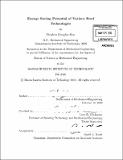Energy saving potential of various roof technologies
Author(s)
Ray, Stephen D. (Stephen Douglas)
DownloadFull printable version (23.20Mb)
Other Contributors
Massachusetts Institute of Technology. Dept. of Mechanical Engineering.
Advisor
Leon R. Glicksman.
Terms of use
Metadata
Show full item recordAbstract
Unconventional roof technologies such as cool roofs and green roofs have been shown to reduce building heating and cooling load. Although previous studies suggest potential for energy savings through such technologies, many factors affect potential savings. To further investigate these factors, a tool has been developed to allow architects and designers the ability to quickly assess the energy saving potential of different roof technologies and roof constructions for various sites around the world. A first principles heat transfer model is developed for each of the roof technologies, with particular care for green roof heat and mass transfer. Two sets of experimental data from Japan and Florida validate the models by predicting roof surface temperature. The predicted roof surface temperatures in Japan agree with measured values within 10 and 26% of peak roof temperature fluctuations for the cool and green roof respectively, while the same models in Florida agree with measured values there within 7.2 and 14% for the cool and green roof respectively. The models have been integrated into a free online building simulation tool, MIT's Design Advisor, available at http : //designadvisor.mit.edu. Numerous simulations are run, showing that potential energy savings are found to strongly vary with many parameters, particularly roof type, climate, and amount of insulation. For example, a one-story building in Boston with an uninsulated modified-bitumen roof can save 82% in cooling and heating energy by adding 3 m 2K/W of roof insulation, whereas only 34% if an uninsulated green roof is installed instead. However, in Lisbon, the same addition of roof insulation to the same building results in 54% savings, while the installation of an uninsulated green roof results in a 67% reduction. Such findings and their implications are discussed for other locations and design parameters.
Description
Thesis (S.M.)--Massachusetts Institute of Technology, Dept. of Mechanical Engineering, 2010. Cataloged from PDF version of thesis. Includes bibliographical references (p. 159-168).
Date issued
2010Department
Massachusetts Institute of Technology. Department of Mechanical EngineeringPublisher
Massachusetts Institute of Technology
Keywords
Mechanical Engineering.